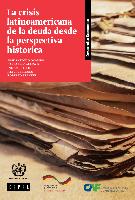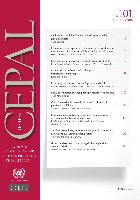- Biblioteca CEPAL
- Biblioguias
- biblioguias
- Raúl Prebisch and the challenges of development of the XXI century
- The balance of payments as a constraint on growth
Raúl Prebisch and the challenges of development of the XXI century
The balance of payments as a constraint on growth
Prebisch understood that Latin America's recurrent balance-of-payments crises placed a severe restriction on the region's economic growth and acted as a bottle-neck in the process of industrialization.
The balance of payments is the sum of the results of the trade balance and the balance on the capital account. It is the accounting balance after calculation of a country’s total inflows and outflows, whether in terms of trade movements, investment, loans, repatriation of capital or migrants' remittances. The balance of payments is said to limit economic growth when the rate of that growth is restricted by the availability of external resources. This difficulty is supposed to be determined by the production structure of the peripheral countries and by the system's tendency to reproduce the characteristics of that structure, hence the term structuralism.
In the course of his intellectual analyses, Prebisch studied this problem from different angles.
1. Worsening of the terms of trade
This issue is examined in greater depth in another section. The terms of trade are the result of changes in the prices of exported goods and services, on the one hand, and the prices of the imported goods and services, on the other. Raúl Prebisch maintained that commodity prices tended to increase at a slower rate than the prices of manufactured goods. Since the peripheral countries specialized in the production of raw materials and the developed countries in industrial production, the worsening of the terms of trade meant that in order to maintain the trade balance in equilibrium and continue to import the same quantities of goods and services, the peripheral countries would need to export greater volumes of commodities. The worsening of the terms of trade is due to the special characteristics of the labour markets and production structures in these two types of countries.
2. Income elasticity of demand
Another assertion made by Prebisch to explain how the balance-of-payments position constrains economic growth is that the income elasticity of demand for the commodities that Latin American countries specialize in is lower than for the manufactured goods they import. The income-elasticity of demand of a given good is the percentage change that this demand undergoes in response to the percentage changes in income. Income elasticity is normally positive, but may be greater than 1 if the product is buoyant or less than 1 if it is a traditional good, to use the terminology of the times. This narrow production specialization not only places a recurrent pressure on the trade deficit, but also has an impact on the rate of technological change, since one of the triggers for the latter is an increase in demand.
The surge in structuralist ideas occurred at a time when world trade was dominated by a shift from the export of raw materials by the peripheral countries and import of manufactured goods from the industrialized nations towards a phase in which the predominant trend was towards inter-industrial trade between developed countries. Industry took better advantage of economies of scale than agriculture and was more subject to technological change and increases in productivity and in employment than the primary sectors. Promotion of industrialization was therefore seen as the path to development. Subsequent deindustrialization of the developed countries, the advance of information technologies and the emergence of new modern services pose unprecedented challenges in this debate.
3. Cyclical movements
Balance-of-payments constraints on economic growth in Latin America are often masked by the intensity of cyclical swings. The latter respond to variations in raw material and food prices and also to the sharp volatility of capital flows, which usually coincide with those of the export sector. Thus, Latin America has often experienced an abundance of external resources, which has generated expectations that this long-term trend has been exceeded. To date, however, these gluts of external resources have been followed by major balance-of-payment crises.
Prebisch and ECLAC never viewed these trends as inevitable or irreversible, but stressed the need to adopt various policy measures to reverse them.
-
Full-text document The balance of payments as a constraint on growth
Related documents
-
 La crisis latinoamericana de la deuda desde la perspectiva histórica.
by
Publication Date: 2014LC/G..2609-P. 176 p.
La crisis latinoamericana de la deuda desde la perspectiva histórica.
by
Publication Date: 2014LC/G..2609-P. 176 p. -
 Raúl Prebisch and the dilemma of development in the globalised world
by
Publication Date: 2010Revista CEPAL No.101. (LC/G.2455-P)
Raúl Prebisch and the dilemma of development in the globalised world
by
Publication Date: 2010Revista CEPAL No.101. (LC/G.2455-P) -
 Inflación y balanza de pagos: la influencia del pensamiento de la CEPAL en los años sesenta y ochenta
by
Publication Date: 2000En: La CEPAL en sus 50 años: notas de un Seminario Conmemorativo - p. 53-59. (LC/G.2103-P)
Inflación y balanza de pagos: la influencia del pensamiento de la CEPAL en los años sesenta y ochenta
by
Publication Date: 2000En: La CEPAL en sus 50 años: notas de un Seminario Conmemorativo - p. 53-59. (LC/G.2103-P) -
 Saving and investment under external and fiscal constraints
by
Publication Date: 1989-08CEPAL Review, No.38. p. 31-47. (LC/G.1570-P)
Saving and investment under external and fiscal constraints
by
Publication Date: 1989-08CEPAL Review, No.38. p. 31-47. (LC/G.1570-P) -
 Políticas macroeconómicas y brecha externa: América Latina en los años ochenta
by
Publication Date: 1989Libros de la CEPAL No.18 (LC/G.1532-P)
Políticas macroeconómicas y brecha externa: América Latina en los años ochenta
by
Publication Date: 1989Libros de la CEPAL No.18 (LC/G.1532-P) -
 Review of the theoretical approaches to external adjustment and their relevance for Latin America
by
Publication Date: 1987-08CEPAL Review , No.32. p. 169-208 (LC/G.1473)
Review of the theoretical approaches to external adjustment and their relevance for Latin America
by
Publication Date: 1987-08CEPAL Review , No.32. p. 169-208 (LC/G.1473) -
 Política monetaria y el ajuste de la balanza de pagos: tres estudios
by
Publication Date: 1980Cuadernos de la CEPAL No.29 . 61 p. (E/CEPAL/1088)
Política monetaria y el ajuste de la balanza de pagos: tres estudios
by
Publication Date: 1980Cuadernos de la CEPAL No.29 . 61 p. (E/CEPAL/1088)

